When I discussed underwater protection, I focused only on the systems designed to keep water out of the ship. But naval architects had long been concerned about flooding, and included a second line of defense to deal with water that got inside the ship. This could be from a torpedo, a mine, a shell hit near the waterline, being rammed by another ship, or even running into rocks. In any case, the basic principles were the same, as were the problems they faced.
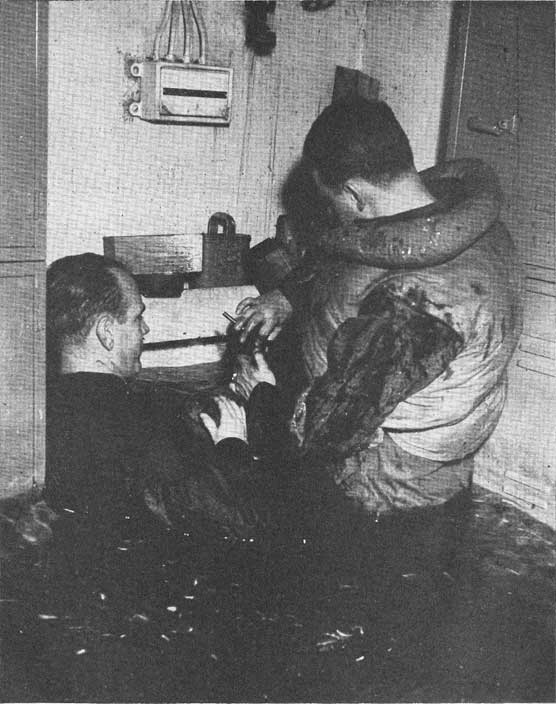
Patching a hole in a partially-flooded compartment
The first and most important line of defense was compartmentalization. Ships sink when the inside fills with water, and dividing the interior of the ship up into watertight compartments means that, in theory at least, the ship will only sink if enough of those compartments are damaged and opened to the sea. The downside to this arrangement is that watertight bulkheads get in the way of actually using the space. Machinery, for instance, requires large spaces below the waterline, and living spaces are more difficult to use if access routes have to go through a limited number of doors. The resulting inefficiencies drive up cost and ship size. As a result, standards have been developed specifying that all large ships, military and civilian, must be able to remain afloat and stable with a certain number of compartments flooded. The general measure of resistance to sinking is known as "reserve buoyancy", and is calculated as the volume of the hull between the waterline and the height at which water will begin to enter the ship if the ship sinks that far.1
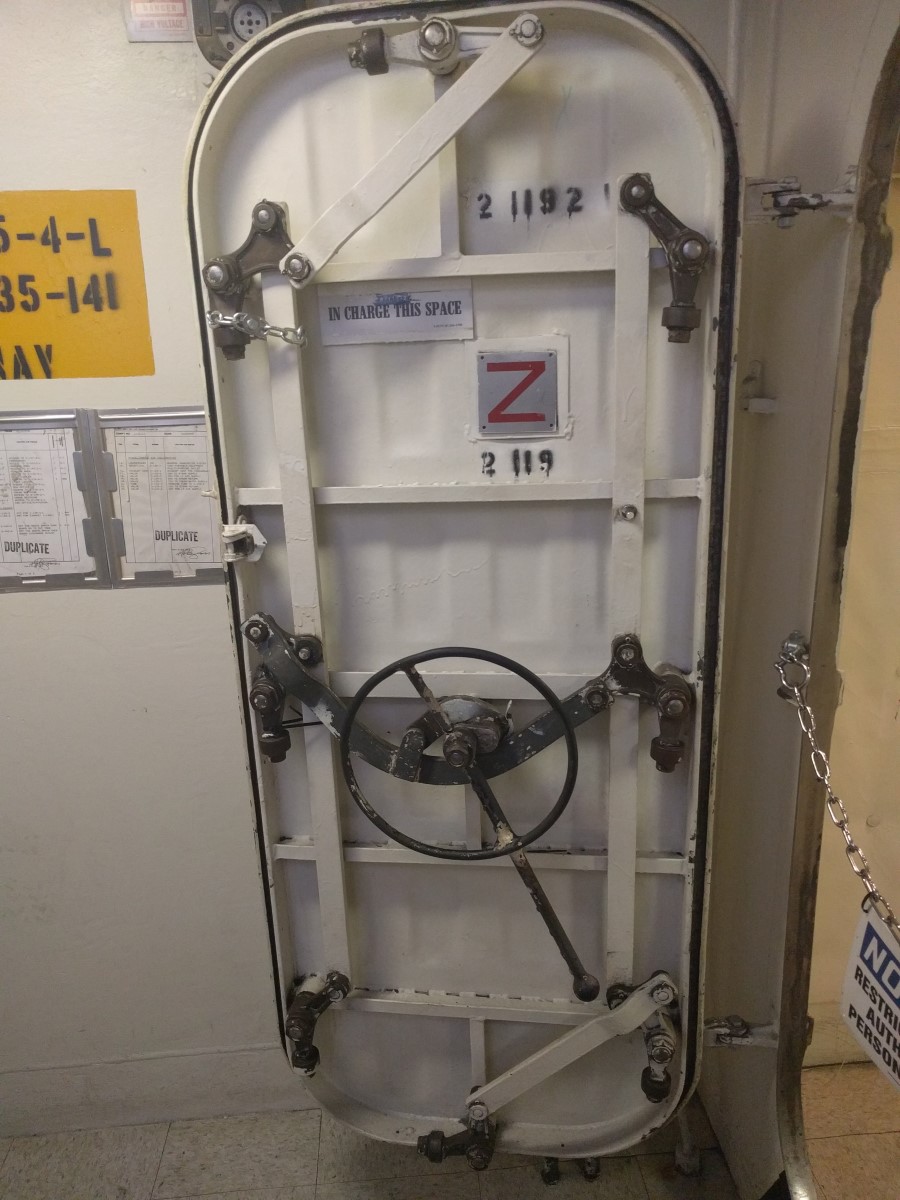
A typical watertight door aboard Iowa
Warships often supplement these with standards based on weapon damage. The USN, for instance, would estimate the effects of underwater damage based on the theory that a torpedo hit would damage a certain length of a ship's side. This "damage" would be placed at the point on the ship calculated to cause the most flooding, and the stability and buoyancy would be checked again. This standard resulted in a late revision to the design of the Iowas. The original plan had been to use unit machinery, where each of four rooms would contain two boilers and a turbine. However, this would have resulted in 64' machinery spaces, for a total flooded length of 128 ft. This was unacceptable, and the ships were redesigned with separate engine and boiler rooms, each 32' long. There was a slight increase in displacement, but it was acceptable since the treaties had been suspended at the start of the war.

A riddled bulkhead, another possible route for progressive flooding
Unfortunately, keeping a ship afloat after damage is not just a matter of making sure that the designers provide enough compartments. A ship that is simply a collection of sealed compartments would be very difficult to sink, but also not very useful. Men, cables, pipes, and even voice tubes need to get in and out of compartments, and these all open up paths for water to penetrate undamaged bulkheads. The most obvious path is a watertight door that is left open due to the ship being unprepared or her crew not following proper procedure. But water is insidious, and unless care is taken, any penetration of a bulkhead will allow water through. Cable glands leak if not maintained, ventilation systems are natural flooding paths and the seals on watertight doors are easily damaged by careless sailors or compromised by dirt. The result is known as progressive flooding. Designers learned to mitigate this by designating a damage-control deck above the waterline, and limiting communication between compartments below it. For instance, there is no way to go from one of Iowa's engine room to another below Broadway, well above the normal waterline, and where possible cable and pipe penetrations are kept above this deck, too.
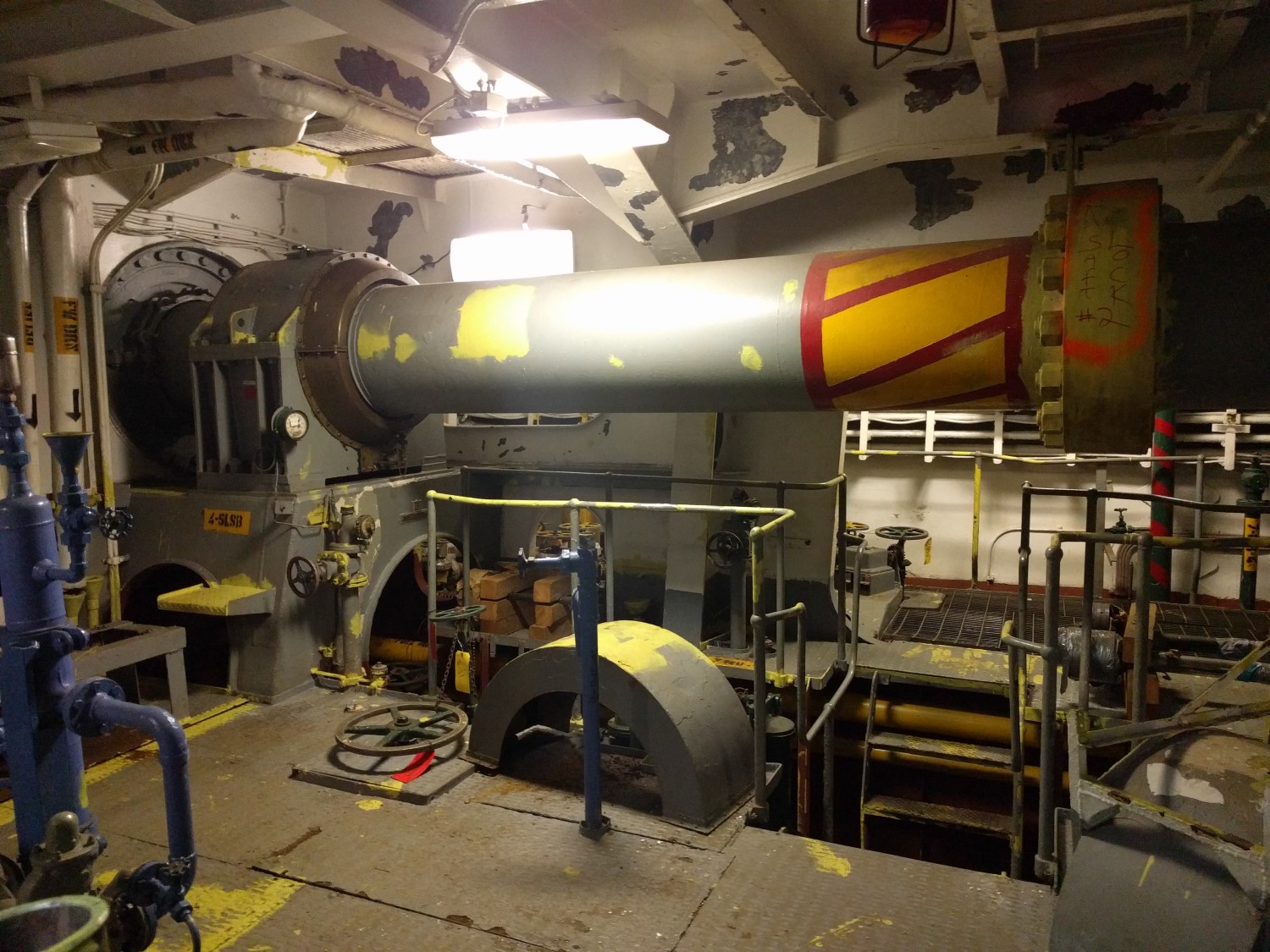
One of Iowa's shafts
Unfortunately, some penetrations couldn't be kept above this deck, most notably the propeller shafts. While the shafts themselves are not normally substantial leak paths,2 in the event of damage, things can go very bad very quickly. The most notable case of this was when Prince of Wales was torpedoed off Malaya. Her still-rotating port outboard shaft bent under the force of the explosion, ripping open the glands and causing extensive flooding. The damage was so bad that a diver on a recent survey was able to travel the entire length of the shaft from outside the hull to the engine room where it terminated. Unfortunately, damage like this is essentially impossible to prevent, although good detail design of the shaft components can mitigate it some.
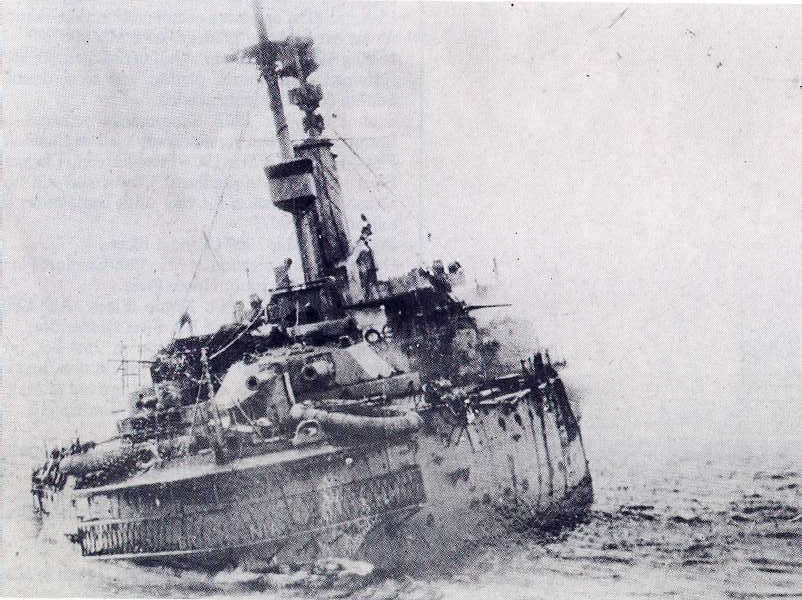
HMS Britannia, shortly before she capsized
But the picture was even more complicated than that. Besides simply flooding and sinking lower in the water, ships also capsized. This was often due to the designers installing longitudinal bulkheads in the machinery spaces, which divided the relevant space into port and starboard sections. Any damage resulted in off-center flooding, and a badly-listing ship, made worse by the free-surface effect. All six British pre-dreadnoughts that were sunk by torpedo attack during WWI capsized,3 thanks in part to another design problem. As the ship listed, the water reached the casemates and began to flood into the ship. This in turn made the list worse, and the ship quickly capsized.
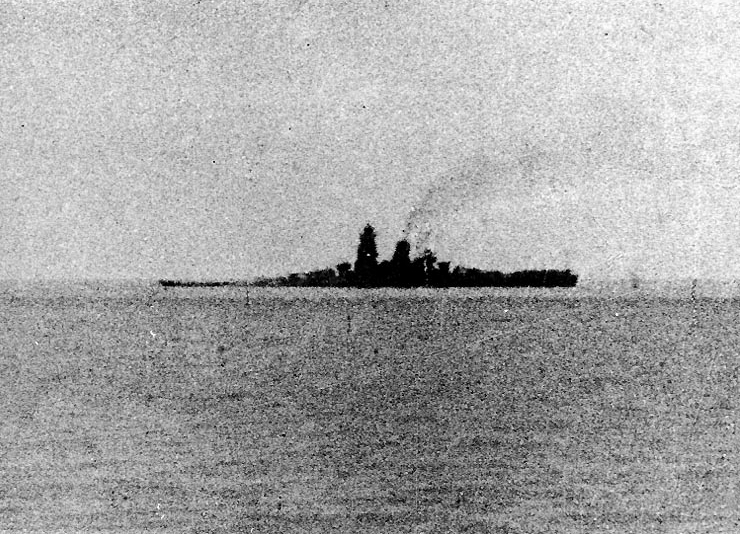
Musashi down by the bow, shortly before she sank
After the war, some navies, most notably the USN, avoided longitudinal bulkheads entirely. This meant that the ship was not as compartmentalized as possible,4 but was also quite resistant to capsize. It didn't mean that the ship couldn't capsize, but most American ships capsized after flooding had destroyed their stability. This was in contrast to the Japanese, who used longitudinal bulkheads on most of their ships, and sometimes paid the price for it. An excellent illustration is the fates of the two Yamato class battleships. Musashi was attacked on both sides and took 19 torpedoes and 7 bombs before sinking. The USN, who had a reasonable idea of Japanese design standards, ordered the pilots going after Yamato six months later to attack only on the port side. Most of them did so, and it took only 11 torpedoes and 6 bombs to sink her.5
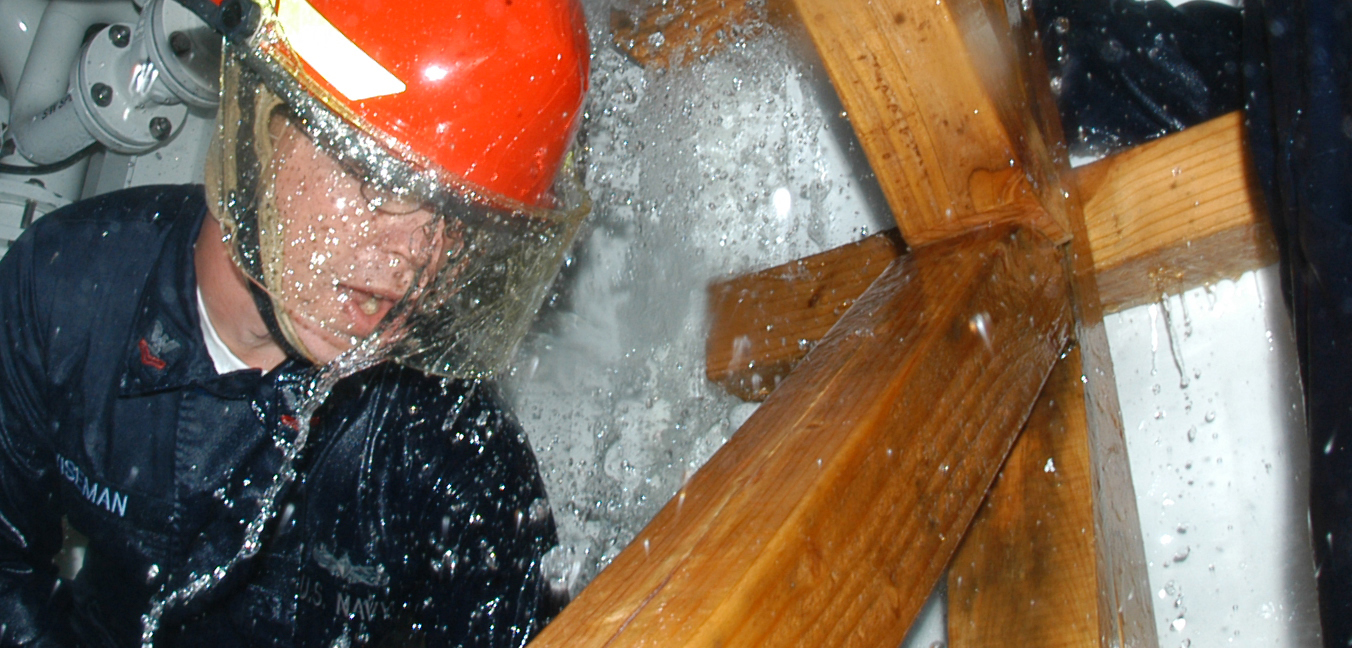
A sailor checks shoring during a damage control exercise
A competent crew could significantly increase survivability against flooding. Besides maintaining watertight integrity through regular maintenance,6 they were able to fight back after damage. Standard damage control procedure was to establish the flooding boundaries, where the crew would make their stand to contain the water pouring in. This selection involved evaluation of the damage and leakage rates in the bulkheads, and the availability of pumps to remove water that made it through. Damaged bulkheads would be supported by shoring, the creation of temporary wooden supports to take the strain off of the bulkhead, and leaks would be gradually found and stopped. If there was a serious list, for instance due to flooding in the TDS, undamaged spaces on the other side of the ship could be counterflooded to restore an even keel.
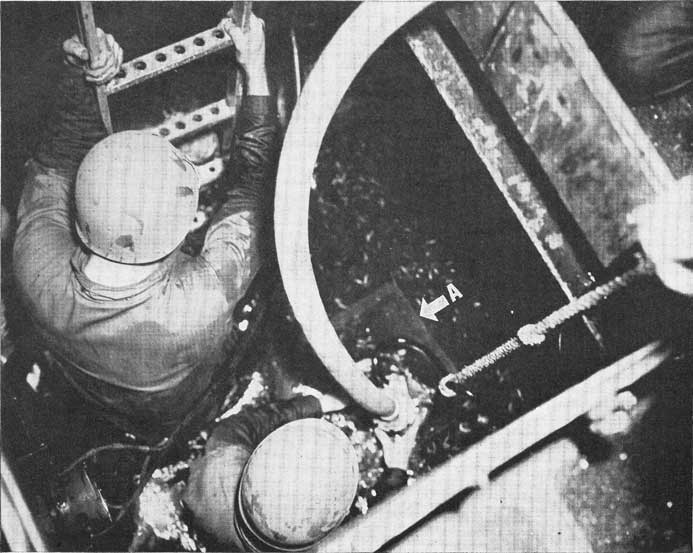
Dewatering a compartment. Note the strainer employed to protect the pump from debris.
After the flooding boundary was established, the crew would attempt to dewater the flooded spaces. In many cases, the leakage rate would be low enough that pumps could get most of the water out of a space, allowing the crew to go in and patch leaks, close watertight doors that were left open, and eventually dry the compartment out completely. Divers might be sent in if the pumps were insufficient, to clear blocked drains, close doors, and patch any large leaks that prevented normal dewatering.
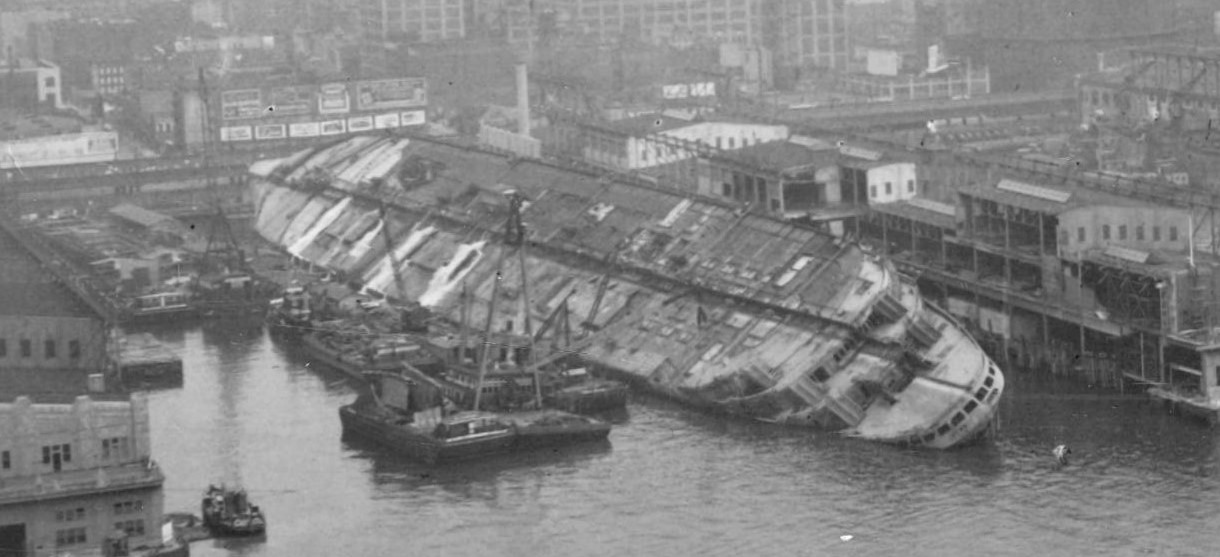
Normandie capsized in New York Harbor
Weirdly, underwater damage was not the only possible cause of flooding. Firefighting involved spraying lots of water around, and it could build up and eventually cause stability problems. The most notable case is the French liner Normandie,7 which caught fire pierside and eventually capsized due to free surface from the firefighting water.
Ultimately, flooding was probably the greatest danger to battleships in action, but far from the only one. Fire, structural failure, and magazine explosions were also major threats, and the prospect of a mission kill from above-water damage was never far from the minds of the designers, either.
For more information on the mechanics of flooding and how it was fought, see the 1945 USN Damage Control Handbook. Here is a good video from Tom Scott of the RN's flooding control trainer, focusing mostly on the use of wooden wedges to plug holes. And you can experiment with this yourself, at least in 2D, with Sinking Simulator.
1 This was one of the major causes of the loss of HMS Victoria, which sank when water reached the gunports. The other major factor was insufficient watertightness, as doors were either not closed or leaked, and other paths for progressive flooding undermined any attempt to combat the flooding. ⇑
2 I say "substantial" because in normal operation the aftmost shaft gland does drip a thin stream of water into the ship. This is necessary to allow the shaft to rotate, and is easily handled by the bilge pump. ⇑
3 Four more were sunk by mines. One capsized, two more sank with large lists and the only one that sunk upright was reported to have suffered damage to the center bulkhead. ⇑
4 Iowa's boiler rooms could almost certainly have been divided in half at minimal cost in weight, for instance. ⇑
5 Interestingly, the third of the Yamatos, Shinano, was converted to an aircraft carrier and sunk by the submarine Archerfish on her first trip to sea. She succumbed to progressive flooding due to a lack of watertightness and an untrained crew. ⇑
6 Compartments were often tested by raising air pressure above atmospheric, then seeing how quickly the pressure dropped. ⇑
7 Technically, she was known as Lafayette at the time, as she was taken over by the US after the fall of France. ⇑

Comments
I am not a naval engineer, and the Navy seems fairly tradition bound for a number of reasons, but it seems like Azipods or similar would be a good way around the propeller tunnel problem, at least going forwards? Not only do they get rid of the propeller shaft, they also allow the powerplant to be installed higher up, which means less ducting, fewer penetrations, and potentially fewer downflooding problems.
The big problem with azipods, AIUI, is power. (That, and they didn't exist during WWII.) Oasis of the Seas, the world's largest cruise ship, has three azipods of 26,000 hp each. An Arleigh Burke has four LM2500 turbines of about the same power each. And it's a much smaller and lighter vessel, with much more stringent requirements for a high T/W propulsion system. Almost all of the advantages you mention can be achieved with electric propulsion and conventional propellers, and that looks to be the emerging standard for warships. I'm tempted to begin describing the US turboelectric battleships as "the most advanced ever built" and "a century ahead of their time".
Has any work been done with active measures to keep damaged ships afloat? I'm thinking of things like (wild speculation) inflatable pontoons that could be used to increase the buoyancy.
Not that I know of, although it's an interesting idea. The biggest problem I see with any system of that kind is that it's a bit Rube Goldberg, and that's not something you want to hear when you're dealing with battle damage. If the bags are external, you have the issue that they're fairly likely to be affected by whatever caused the flooding in the first place, and they're pretty vulnerable to sea conditions, and rough seas are when you need the buoyancy the most. Not to mention the structural issues you're going to face.
A better option might be to make them internal, essentially deployable water-excluding material. They'd have to be very sturdy so they didn't get punctured during the initial impact or by debris when deployed, and there might be safety hazards if you have people in the compartment. Overall, probably not worth it. But still, a very interesting thought.
Tom Scott did a good video on flooding control. The RN let him and some mates try out their Damage Repair Instructional Unit at HMS Excellent while wearing GoPros.
https://www.youtube.com/watch?v=xXC6U0NfJg8
@Lambert
Very cool. I've added a link to the video in the main post.
Your picture of the Normadie (USS Lafayette) led me to an interesting read on Wikipedia. The ships designer, Yukourvitch arrived at NY Harbor as fire fighting efforts were underway. He was barred entry to the scene by the harbor police...
He did, however, advocate opening the sea cocks to flood the bottom of the ship and allow it to settle on the shallow bottom--thus preventing a capsize.
Suggestion duly ignored, the ship listed all the way over. Yet another instance in life of something that did not need to end as it did. Granted I can imagine the confusion that was extent at the pier and onboard, but still...
Interesting. I hadn't heard that story. I think the bigger issue was NYFD ignorance of the stability problems that can come from firefighting, and not specifically that the designer had special insight into the problems.
@Bean
The Wiki article agrees with you about the instability brought about by the firefighting techniques. It did seem to imply however, that the designer somehow had enough info to know that this effort could lead to a precarious list and that he advocated getting the ship to settle in the shallow per area before the list became too pronounced.
My bad in my previous post as I definately did not mean to imply that Yukourvitch had an ideas at hand that would have prevented this from being a bad situation all around. The ships internal fire fighting system had been deactivated during its period of internment. Then, when the fire brigade arrived they saw that their fittings did not correspond to the French design (Imperial versus metric?). A clasic error chain of events if there ever were one.
This is actually getting more interesting the more I look at it. The Navy salvage report indicates that the list was noticeable as early as 1530, an hour after the fire started, and had reached 40 degrees by 2330, about three hours before she capsized. I'd love a more detailed account of why they didn't manage to do something in the ensuing 8 hours, but the level of detail I want doesn't seem to be available online, and I'm not going to spend the kind of money required to figure it out.
Regarding longitudinal bulkheads, the problems described seem to be more failures of damage control (failing to counterflood promptly, or possibly at all) than failures of design. Even without longitudinal bulkheads, underwater damage will still cause off-center flooding and a list, due to the free-surface effect; worse, an absence of longitudinal bulkheads renders counterflooding useless as a method for correcting this list, since attempting to counterflood will cause all the water in the flooded compartments to surge across to the other side of the ship, so now the ship is listing at least as badly in the other direction, and is lower in the water to boot. If you don't recognize what's going on, and instead try to correct it by counterflooding in the other direction, you'll end up flopping the ship from side to side, settling further down each time, until the ship either founders or capsizes. (This sort of thing - flooding combined with a lack of longitudinal bulkheads resulting in the free-surface effect running rampant - can be seen in the sinking of Kirishima, where flooding across the middle deck [and later the main deck as well], combined with attempts to fix the resulting list via counterflooding, rolled the ship over after a few initial flops; although the flooding from several 16" shell hits below the waterline meant that the ship was going to founder eventually in any case, the end was greatly accelerated by the absence of longitudinal bulkheads to confine incoming water to one side of the ship.)
In contrast, if the ship does have longitudinal bulkheads, a flooding-induced list can be rectified by counterflooding, since the longitudinal bulkheads keep the incoming water on the same side it entered the ship on and prevent it from surging across the ship and causing an equal or greater list in the opposite direction.
I think the counterpoint from the "no longitudinal bulkhead" side is that if not flipping the ship requires counterflooding the undamaged half, then you haven't really gained much by putting in the centerline bulkhead. Leaving it out basically counterfloods automatically and gives you a better machinery layout to boot.
I would also be wary of citing early-war Japanese DC practices in an argument for the centerline bulkhead. They were really bad at it.
@bean How does omitting the longitudinal bulkhead "counterflood automatically"? As soon as the ship rolls even a tiny bit to one side, all the water is going to rush to the low side and produce an uncorrectable list.
And on a ship without longitudinal bulkheads, even if you don't make the situation worse by trying to counterflood, you still have a list which brings the hull openings on the flooded side closer to the waterline (making the ship more vulnerable should it take additional damage or encounter heavy seas) and interferes with working the main guns.
I think you're overestimating how much effect you get from free surface. There are lots of ships which had substantial flooding and no longitudinal bulkhead and didn't capsize. Houston springs prominently to mind here. No longitudinal bulkhead lets the water spread out across the ship, at least partially counterbalancing the stuff on the low side. With the bulkhead, everything is on one side, and the list is going to be at least as bad if not worse than the no bulkhead configuration.
It only requires counterflooding the whole undamaged half if for some reason you only have one longitudinal bulkhead. As long as you have multiple longitudinal bulkheads (which you should do anyways if you're going to use longitudinal bulkheads, because it reduces the volume of ship that can be flooded by any given hull rupture), damage-induced flooding on one side can be compensated for by counterflooding on the other side while still leaving the compartments in between dry.
Wait. I think you're confused about what longitudinal bulkheads mean in this context. At least for battleships, "no longitudinal bulkheads" means that the main breadth of the ship, inboard of the TDS, is open from side to side. Yes, the TDS is composed largely of longitudinal bulkheads, but I think the designers thought was was obvious and used longitudinal bulkheads to talk about the type that are optional, not effectively mandatory. And if you can fit your machinery into small compartments so that the underwater section is nicely chopped up (see the US turboelectric ships for the best example) then longitudinal bulkheads in this usage are fine. They're a really serious problem if you're thinking about splitting your machinery spaces clean in half, like they did on the pre-dreadnoughts, as evidenced by how many of them rolled over.
@bean I'm using the same definition of "longitudinal bulkheads" as you are - longitudinal partitions inboard of the TDS.
Agreed, the optimal solution is to have the machinery spaces well-subdivided both longitudinally and transversely... which raises the question of why so few navies did so.
Because you can't, at least in the machinery spaces. The engine rooms on Iowa are fairly full of turbines, and I don't think you could split them even in half, although it probably could have been done if that was a design driver from the start. You could easily split the boiler rooms in half, but again, capsize. If you had a bit more beam (say 115' on the waterline) and a bit less power (maybe 172,000 SHP), you could look at dividing the machinery plant into thirds, which greatly reduces the asymmetry problem. There's a diagram of a plan for this plant on p.340-341 of my Friedman.
@bean Hmm. Is the main problem the diameter of the turbine rotors (which could probably be solved by going from a few large-diameter turbines to a greater number of small-diameter turbines), their length (maybe mount the turbine vertically and bevel-gear it to the shaft?), or something else?
It's that the current turbines are built for full-width engine rooms. There are a number of possible solutions, and even just squeezing the HP and LP turbines closer together and redesigning the reduction gears would probably work well enough if they were really determined on a centerline bulkhead. But they had noticed that ships with those had an annoying tendency to tip over, so there was no reason to.
The main thing to do with the turbines is to spin them faster. That reduces both rotor diameter and the number of stages, while everything else (steam flow, supply and exhaust pressure) stay the same. Add a third reduction gear stage to convert to the rpm and torque that was produced by the previous turbine design. (It can be relatively speaking small and light, if cooled; only the final drive needs to be massive, as only that deals with propeller shaft torque.)
Separate question: was there ever an attempt, similar to turbo-electric, for a turbo-hydraulic drive? Its advantage over gears-and-shafts is compartmentalization; its advantage over electric is that liquid compressors take less volume per kW than electric generators/motors, and that in the early 20th c., it's less finicky/temperamental.
This is an era where double-reduction is still cutting-edge. The USN may have been the only one to use it on their battleships, although I'm not 100% sure on that. I know the British didn't.
Yes, there was an investigation of turbo-hydraulic. The Germans planned to use it on the battlecruiser Furst Bismarck. I don't really have any other data about it, unfortunately.
Basil Marte:
Even by that point electric generators and motors were probably the less temperamental technology, at least at those scales.